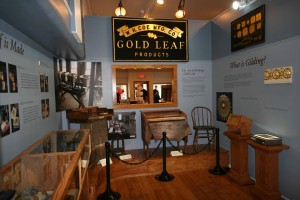During summer 2012, a new mini-museum was added within the Walldog Museum. The Museum of Gilding Arts has a small temporary display in one of the rooms of our building. Gilding is the application process of gold leaf. However, within this small room the Society of Gilders has shown more than just gilding. The first part of the room shows the process of how gold leaf is made, depicted in the picture provided. The other part of the room depicts “How to Gild” and where one would typically see gilding.
The exhibit is temporary as the Society of Gilders would like to move into another building in Pontiac, to have a full on museum. They are currently in the process of scouting out available buildings. After visiting and working with the city, the society decided to use Pontiac as their home for the museum, a school to teach gilding, and more. The news about the society has been both very exciting and rapidly developing. We look forward to working with the group in the future and watching them help develop the tourism in downtown Pontiac.
If you have not seen the display yet, please stop by! The museum is open 7 days a week with the hours listed below:
November-March 10a-4p daily
April-October 9a-5p Monday-Saturday 9a-4p Sundays


Craftsmen in Traditional Water Gilding and Oil Gilding techniques for Indoor & Outdoor Projects Architectural Gilding: statues, sculptures, walls, railings, gates, staircases, ceilings, cornices, columns… Gilding of decorative art objects: furniture, frames, mirrors… Gilding restoration: cleaning, reconstruction of missing ornamentation Fine Art paintings: cleaning-removal of soiling/varnishes Gilding on all supports: wood, plaster, lead, iron, bronze, copper, resin, canvas, marble, ceramics, glass, fabric… Gilding for residential, commercial , historical or Public buildings Gilding for private homes, antique dealers, art collectors and museums Master Gilders brings the traditional art of gilding to California and beyond and welcomes inquiries from individuals and design professionals alike.
Our studio was originally commissioned to conserve all the original water gilding for the ballroom, but it evolved into a full-scale restoration project. However, in our initial investigation of the room’s condition, we discovered that the original gilders had problems with the adhesion of the gesso on the chain rail. We found four separate gilding layers on the chair rails.
The beginnings of the living history museum can be traced back to 1873 with the opening of the Skansen Museum near Stockholm, Sweden. The museum’s founder, Arthur Hazelius , began the museum by using his personal collection of buildings and other cultural materials of pre-industrial society.